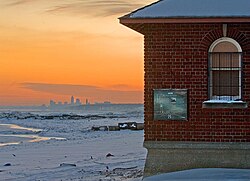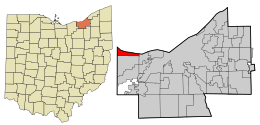Bay Village, Ohio
| Bay Village, Ohio | |
|---|---|
| City | |

Winter view of Cleveland's skyline from Huntington Beach
|
|
 Location in Cuyahoga County and the state of Ohio. |
|
 Location of Ohio in the United States |
|
| Coordinates: 41°29′3″N 81°55′36″W / 41.48417°N 81.92667°WCoordinates: 41°29′3″N 81°55′36″W / 41.48417°N 81.92667°W | |
| Country | United States |
| State | Ohio |
| County | Cuyahoga |
| Government | |
| • Mayor | Paul Koomar (R) |
| Area | |
| • Total | 7.06 sq mi (18.29 km2) |
| • Land | 4.57 sq mi (11.84 km2) |
| • Water | 2.49 sq mi (6.45 km2) |
| Elevation | 633 ft (193 m) |
| Population (2010) | |
| • Total | 15,651 |
| • Estimate (2015) | 15,402 |
| • Density | 3,424.7/sq mi (1,322.3/km2) |
| Time zone | Eastern (EST) (UTC-5) |
| • Summer (DST) | EDT (UTC-4) |
| ZIP code | 44140 |
| Area code(s) | 440 |
| FIPS code | 39-04416 |
| GNIS feature ID | 1064393 |
| Website | http://www.cityofbayvillage.com/ |
Bay Village is a city located west of Cleveland in Cuyahoga County, Ohio, United States. The population was 15,651 at the 2010 census. Bay Village is located in Ohio's 9th congressional district.
Before the first white men explored the area around 1600, Erie Indians lived in Bay Village and the surrounding areas. The most important Indian trail in Ohio is present-day Lake Road, which is a main road in Bay Village. In that same century, what is now Bay Village, along with Avon Lake, Avon, and Westlake, was part of one territory. This territory was later called by the whites in a native language, "Xeuma", a term roughly meaning "those who came before us".
The area belonged to Connecticut until 1803, the year in which Ohio became a state. Before 1803, the Connecticut Land Company sold and gave away land in the area to Connecticut citizens, who had lost their homes and farms during the Revolutionary War. Because many had lost their homes to fires during the war, this new area was named “the Firelands”. One surveyor with the Connecticut Land Company was Moses Cleaveland. He came with his friends on horseback from Connecticut and stopped at the Cuyahoga River with his Indian guides in July 1796. The land was then divided into five townships. The area between the Cuyahoga River and The Firelands to the west was laid out in 1806.
Joseph Cahoon settled the City of Bay Village in 1810. Bay Village was part of the original Dover Township. Bay Township split from Dover Township in 1901. In 1903, Bay Village was incorporated, and the first mayor and council were elected. In 1917, the last Cahoon descendent died, leaving the family home and 115 acres of land to the city. John Huntington, one of the original partners of Standard Oil Company, donated his summer estate to the Cleveland Metroparks. Bay Village became a city on January 1, 1950, when it had reached a population of 6,917.
...
Wikipedia
